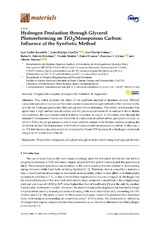Hydrogen Production through Glycerol Photoreforming on TiO2/Mesoporous Carbon: Influence of the Synthetic Method
Autor
Escamilla, Juan Carlos
Hidalgo-Carrillo, J.
Martín-Gómez, Juan
Estévez, R.
Montes, Vicente
Cosano, Daniel
Urbano Navarro, Francisco José
Marinas, Alberto
Editor
MDPIFecha
2020Materia
TiO2/carbon compositesSol-gel process
Glycerol photoreforming
Hydrogen production
METS:
Mostrar el registro METSPREMIS:
Mostrar el registro PREMISMetadatos
Mostrar el registro completo del ítemResumen
This article explores the effect of the synthetic method of titanium dioxide (TiO2)/C composites (physical mixture and the water-assisted/unassisted sol-gel method) on their photocatalytic activity for hydrogen production through glycerol photoreforming. The article demonstrates that, apart from a high surface area of carbon and the previous activation of its surface to favor titania incorporation, the appropriate control of titania formation is crucial. In this sense, even though the amount of incorporated titania was limited by the saturation of carbon surface groups (in our case, ca. 10 wt.% TiO2), the sol-gel process without water addition seemed to be the best method, ensuring the formation of small homogeneously-distributed anatase crystals on mesoporous carbon. In this way, a ca. 110-fold increase in catalyst activity compared to Evonik P25 (expressed as hydrogen micromole per grams of titania) was achieved.

